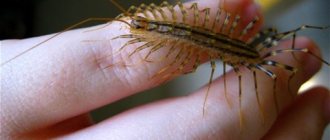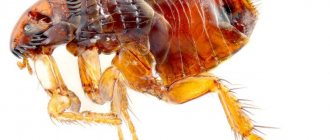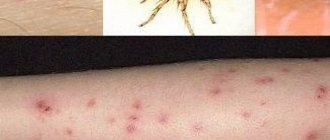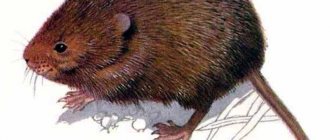Share on social media networks:
A shaggy arthropod creature with numerous long limbs, called the “common flycatcher,” is often found in homes. It is not dangerous to people, but the insect has a very unpleasant appearance, which is why many try to get rid of it. This predatory centipede crawls into apartments and houses due to the abundance of prey - cockroaches, flies, bedbugs, mosquitoes, spiders. The easiest way to remove it is to cut off access to food.
Appearance and lifestyle
The common flycatcher is a centipede from the order Skutiger. It has a flattened oblong body, consisting of 15 segments, and the same number of pairs of limbs, the length of which increases from head to tail. The two outer legs resemble antennae and are not used when moving. The color of the insect is brown (in some varieties it is grayish or greenish) with three longitudinal stripes of dark color. Due to the large number of limbs, the flycatcher appears hairy, but in fact its body is covered with smooth chitin.
The size of the centipede is 3.5−6 cm; in large individuals, the leg span often exceeds the body length. The insect grows throughout its life, shedding its shell during molting. It is active both day and night, but leads a secretive existence and only catches the eye of a person during hunting or transitions between shelters. The centipede feeds on insects - flies, cockroaches, blacktails, midges, mosquitoes, spiders, earwigs, silverfish, and woodlice.
In the wild, the insect lives under fallen leaves, where it searches for prey. Its natural range includes hot and temperate zones of Europe, North Africa and the Middle East, including the Crimean Peninsula, the Volga region, the Caucasus, India, Kazakhstan, and Moldova. It creeps into human homes most often in the fall, when it is looking for warm shelter, but in search of food it can enter the house in the summer.
Flycatchers breed in the warm season. Partners attract each other with pheromones and sound signals. The male weaves a silk cocoon, where he leaves a sac with fertilizing fluid, which is then absorbed by the female. The centipede lays its eggs in the soil, covering them with a sticky secretion for protection. 60-150 larvae hatch from them - at the beginning of life they are small, white and have only 4 body segments. The female looks after the cubs for the first 2 weeks of life, protecting them from enemies.
During a hunt, flycatchers can reach speeds of up to 40 km/h, attacking their prey with lightning speed. They then inject poison into the body of the prey. It is not dangerous for humans and large animals (including cats and dogs), but it kills insects. The lifespan of a flycatcher is longer than that of most domestic insects - up to 7 years. They also differ from them in their more developed intelligence and memory - it is known that they can remember, for example, dangerous and safe places in the house.
Habitat
The common flycatcher can be found in many temperate regions. In Russia, this is the Volga region, the southern regions, the insect lives in the northern part of Africa, Europe, the Middle East, and Mediterranean countries. Under natural conditions, centipedes hide under stones, fallen leaves, and plant remains. The domestic centipede hunts at any time of the day.
They move to human housing with the onset of autumn cold weather. Prefer dark and damp places:
- basement;
- bathroom;
- toilet.
During the winter, the insect hibernates and becomes active only when the weather warms up. In southern countries, centipedes are treated kindly, because they help exterminate pests.
Danger to humans
The flycatcher poses no threat to humans. The insect is very secretive and tries not to be seen, and when faced with danger it tries to escape. It can only bite in self-defense if you try to pin it down. Centipedes also do not tolerate any diseases or parasites.
People are most often afraid of flycatchers because of their unpleasant appearance - many long, quickly moving limbs inspire horror and disgust . In addition, this harmless centipede is often confused with its poisonous relative - the scolopendra, which is similar in appearance, and therefore they mistakenly try to get rid of it.
The centipede will also not cause any harm to a person’s home. This insect feeds exclusively on flies, mosquitoes, cockroaches and other bugs and does not touch human food supplies. Furniture, clothing, wallpaper and paper products are also not included in his diet. Thanks to this, flytraps in the house are very useful - they quickly exterminate pests without side effects. Some summer residents even specially bring them to the site in order to remove flies, cockroaches, moths, ticks and other harmful “neighbors”.
Are centipedes dangerous?
If these arthropods are dangerous, it is only for their potential victims - other insects. They do not pose any threat to humans. All that centipedes in an apartment can do to displease people is their frightening and repulsive appearance or self-defense when trying to kill them manually (the bite is not dangerous, although somewhat noticeable).
In other respects, on the contrary, the centipede can serve a person well by hunting insects, if there are any in the house. Its victims will be:
- cockroaches;
- spiders;
- ants;
- flies (hence another name for the centipede - flytrap);
- bedbugs;
- fleas;
- mole;
- in addition to insects - slugs and snails.
Thus, whether to destroy the flytrap or not is up to the owners of the apartment, who independently decide for themselves whether they are ready to get along with such a creature in the same room or not. But if arthropods multiply excessively, it is unlikely that even the most loyal people to their appearance will want to put up with such a neighborhood (and centipedes reproduce quickly - only one female hatches from 60 to 150 eggs at a time).
Flycatcher bite
An adult flycatcher can bite. Usually her jaws are not strong enough to pierce human skin, but sometimes she manages to sting a child or girl with very delicate skin. The centipede itself will not attack, but it can defend itself when trying to move or kill it.
The bite of a flyeater is not dangerous: the poison is intended to kill small prey, and therefore cannot seriously affect even a child’s body. Symptoms of poisoning resemble a bee or wasp sting: redness, itching, burning, pain at the site of the lesion. The victim must be given first aid, which consists of the following:
- Wash the wound with warm water and soap.
- Disinfect the bite site with any antiseptic, such as alcohol, hydrogen peroxide or boric acid.
- If the damaged skin burns severely or swelling has formed, apply a cold compress to the damaged area.
- If necessary, take an analgesic.
- If the victim has previously had an allergy to insect bites, take an antihistamine.
It is important not to confuse a flycatcher bite with scolopendra poisoning (they look extremely similar, which is why mistakes often occur). It is much more dangerous, and this type of centipede can infect a person simply by crawling across the skin. If the patient develops alarming symptoms - nausea, vomiting, severe weakness, changes in consciousness, swelling of the entire limb - you should immediately inform the doctor, especially when a child, pet or person with a weak heart has been injured.
As first aid, you need to apply a heating pad to the wound - at a temperature of 45 ° C, the scolopendra venom is partially destroyed and its effect weakens.
Origin
The Venus flytrap (see photo) was discovered by Arthur Dobs in 1736, who compared the plant to iron traps used to hunt foxes. It is thanks to its unusual leaves that the flower quickly gained great popularity and aroused the interest of almost everyone.
The flycatcher was later imported to England. In botany, the plant already officially occupied its niche in 1970 thanks to John Ellis, a famous British naturalist.
flycatcher
From its natural habitat, namely wetlands in North and South Carolina (USA), the Venus flytrap has moved to many window sills and greenhouses around the world. In these areas, summers are moderately warm and dry, while winters, on the contrary, are quite cold.
Charles Darwin himself paid great attention to this plant, who studied its abilities and was one of the first to reveal some of its secrets. The appearance of the flycatcher's mouth in order to catch and digest small organisms was only a hypothesis until recently
Soon the curtain rose and the flower appeared in all its glory.
When an insect first touches the flytrap leaves, the plant does not react in any way, it simply goes into standby mode, which lasts about 20 seconds. The carnivorous plant is able to avoid unnecessary “activation” of the trap at the slightest breath of wind or dust particles falling on the leaves.
Homeland of the flycatcher
A team of German biologists went even further in their research. Using molecular biological techniques, they determined that the photosynthetic particles in the plant's leaves are not very different from standard leaves. This is not such an interesting result, but it has its weight in botany, since it is one of the few pieces of evidence that the flycatcher's mouth most likely evolved from its leaves.
Measures to prevent the appearance
The flycatcher will not visit a person’s home if it does not have favorable living conditions. In order not to create them in a house, apartment or country house, it is enough to follow simple preventive measures:
- do not allow moisture to accumulate near the plumbing fixtures, regularly ventilate the kitchen and bathroom;
- dry clothes, rags and towels in a timely manner, do not leave them on the floor;
- regularly check the integrity of pipes, drains and taps, and promptly repair any detected problems;
- seal or fill with sealant all cracks in the floor and walls, including between baseboards;
- clean the bathroom and kitchen, take out the trash and remove dirt from hard-to-reach places;
- check basements and extensions for leaks, call services in a timely manner to troubleshoot problems;
- install screens on ventilation openings and windows to protect against intrusion;
- regularly remove fallen leaves around a private house or cottage so that the centipede does not have an easy way into the house;
- timely find and remove all pests that serve as potential food for flytraps, especially flies, cockroaches, moths, termites and other rapidly reproducing insects.
It can be quite difficult to remove centipedes from the house due to their secrecy and agility. Therefore, it is better to carry out preventive measures in advance - this will scare away not only harmless flycatchers, but also many real pests.
Proper care
Before you place such a plant in your home, you need to carefully study all the points for caring for it. It is imperative to take into account those conditions that are as close as possible to natural ones.
The eastern part of the room is most suitable for the flycatcher. It is in this part that the flycatcher will be able to get as much time in the sun as it needs (approximately five hours). If it is not possible to place the plant in the eastern part, then you will have to provide light artificially. Otherwise, when there is too much sunlight, the flower will have to be protected from the sun.
Humidity
The Venus flytrap needs plenty of water in its soil. It is because of this that the plant is often grown in aquariums, but in this case the plant will definitely need lighting, which can be provided using a regular incandescent lamp
It is important to maintain a distance of 20 cm, and it should be turned on for 14-16 hours
Ventilation
The Venus flytrap is a plant that is accustomed to swampy areas and requires increased humidity levels to maintain it, but the flytrap cannot tolerate stagnant air. Taking this into account, it is necessary to periodically check the room in which the flytrap is located, but at the same time avoid drafts. In summer, it is best to display the flower at least on the balcony or veranda.
Temperature
It is important to consider the temperature at which the Venus flytrap will be kept. In summer, the plant likes an air temperature of at least 21 degrees, but not more than 30, and in winter, temperatures that drop below 6 degrees can destroy the plant
Watering
The plant cannot process microelements contained in tap water, so it should be watered only with special distilled water.
If you follow all the conditions for caring for a Venus flytrap, then it will grow for a long period of time and delight everyone around with its unusual appearance and the fact that it will fight insects indoors. This plant is suitable only for those who are ready to take responsibility and fulfill all requirements.
the original article
and other tips on how to grow a beautiful home garden on the MyOrchids
.
Source
Fighting methods
Even though the flycatcher is dangerous to humans, not everyone wants to live next to such a multi-legged insect. The easiest way to remove it is to deprive it of access to food, that is, get rid of all other arthropod pests. Experiencing a lack of food, house flycatchers will leave their homes on their own in search of better conditions.
Mechanical method
The simplest way to get rid of a flytrap is mechanical. The insect can be killed with any hard object (unlike the scolopendra, it does not have a hard protective shell) or caught and then released into the street. Many people prefer the second option, since the centipede is very beneficial for the environment and depriving it of its life is considered a bad omen in many places.
Flycatchers are quite agile and hidden, so catching them is often difficult. It is better to use a transparent container for this - a glass or jar. They cover the uninvited guest from above, put a piece of paper or cardboard under the bottom, after which they take him outside the home and release him into the wild.
If there are a bunch of flycatchers in the house, then to get rid of them you need to understand why they found human habitation so attractive. Usually these insects crawl into the house by accident and do not find a sexual partner there, so they do not reproduce. When a whole flock appears in a living space, then in addition to them there are large colonies of pests in the house - cockroaches, termites, fleas, moths. In this case, you should not rush and poison flycatchers - it is better to direct your efforts to fight the main threat, and the unpleasant neighbors will eventually leave their home due to lack of food.
Folk remedies
If the number of insects is small, they can be scared away from the house using folk remedies. Two methods are used for this:
- Boric acid. At the same time, it will repel flycatchers and other insects - almost all of them do not tolerate the effects of this substance. You can buy it at pharmacies or fertilizer stores. It is most convenient to use powdered variations, as they are easier to scatter and clean up. Acid is poured into insect habitats - under sinks, bathtubs, and toilets, in areas behind pipes, near cracks in floors and walls. It is important to prevent its contact with medications and food products, as well as limit access to children and pets. When the centipedes disappear, it is necessary to carry out a thorough cleaning and wipe all bait areas with a rag with a disinfectant, and then ventilate the room.
- Red hot pepper. Several pods of this buggy plant need to be very finely chopped, dried and scattered in places where flycatchers run. Like boric acid, this seasoning is destructive to almost all apartment pests, but is not toxic to humans. It is worth clarifying that seasoning from the store will not work - you need a chopped pod, which you can make yourself or buy at the pharmacy.
The advantage of folk remedies is that insects die in shelters - they are poisoned only after they clean their paws. Therefore, the owner will not have to bother cleaning up their carcasses.
Chemical removal
If you cannot remove flycatchers using conventional means, you can use insecticides. This is not recommended, since the use of toxic chemicals often brings more harm to humans than proximity to harmless (and even beneficial ) flycatchers . Common drugs to combat multi-legged neighbors:
- Aerosol "Rapid". It should be sprayed on the walls in places where flytraps accumulate, paying special attention to crevices and hiding places. Before use, be sure to close windows and doors, and remove all food and medications from the room. While working, you should wear gloves and avoid getting the aerosol on your clothes or skin.
- "Combat MultiSpray". Unlike “Rapid”, it is used with open doors and windows. The spray is used to spray areas where insects accumulate or the surfaces on which they move. Only dry and non-absorbent surfaces can be treated, otherwise the product will lose effectiveness.
- Aerosol “Clean House”. It is sprayed on the walls, in the cracks and gaps between the baseboards, after which they leave the room for 2-3 hours, removing all people and pets from there and tightly closing the aquariums and terrariums. The second method of application is to spray the entire contents of the can in the center of the room for complete disinfection, but then you will not be able to go there for 2-3 days.
Conventional poisons and baits against flycatchers are ineffective - they prey on living insects, and therefore do not show interest in them. Sticky traps also do not work against them - arthropods disentangle themselves from them or tear off the stuck paw.
The flycatcher is a completely harmless and even useful insect for the home. To prevent it from bothering a person with its unpleasant appearance, it is enough to drive out the pests on which it feeds from the apartment.
How does it reproduce?
Reproduction of this exotic representative of the flora is possible in several ways.
To propagate by cuttings, you need to cut the leaf without a trap. The cut site is treated with “Kornevin”, the leaf is planted in a container with peat, to which sand can be added. The substrate should be moist, but not wet. The lid is closed and the container is placed in a warm place with good lighting. Such conditions must be observed for three months - until sprouts appear. From this moment, another three months will pass before a full-fledged sprout can be planted in a permanent place of “residence.”
Separation of the bulbs is only possible when the plant is mature. The Venus flytrap feels comfortable in close proximity to its babies. Each branch of daughter bulbs is stressful for an adult plant, then this procedure can be carried out once every three years. The children are carefully separated from the mother plant and placed in separate containers. It is better to treat the cut with crushed coal. During the rooting period, the children are covered with film and placed in a bright place without direct sunlight.
Seed propagation is also typical for Dionaea. This method is the most difficult of all existing ones. Moreover, it is also unpredictable, since the new plant may be completely different from the mother one. Only an adult Dionaea, which is more than three years old, can produce seeds. To propagate Dionaea by seeds, you must adhere to the following guidelines:
- in the spring, during flowering, it is necessary to collect pollen with a brush or cotton swab and transfer it to other flowers;
- with successful pollination, a seed capsule is formed, which will ripen only in the fall and produce full-fledged seeds;
- planting material must be immediately planted in the substrate, since their germination rate will decrease in the future;
- seeds are planted in containers with a lid filled with sphagnum and sand (2: 1);
- seeds treated with “Topaz” are laid out on a damp substrate, the container is closed and left in a sunny place;
- for a month you need to maintain maximum humidity, temperature within 25 - 30 degrees and illumination at least 12 hours a day;
- when the first leaves appear, the container must be ventilated, gradually accustoming the seedlings to fresh air;
- stronger plants can be pruned.
To obtain a plant in this way, you must adhere to the following recommendations:
- a low, young peduncle about 5 cm long is cut off;
- placed in wet peat with a depth of 1 cm;
- greenhouse conditions are created - the container is covered with a film or cap made of transparent material;
- the rooting process will take up to 2 months - during this period you need to maintain a high level of humidity and do not forget about ventilation;
- The peduncle may dry out, but you need to wait the specified time and your patience will be rewarded.
Reproduction
Seeds
During flowering, artificial pollination must be carried out using a cotton swab or a soft brush. If pollination is successful, small seed boxes are formed. After three months, the seeds are ready for sowing. Seeds quickly lose their viability - so you need to sow right away. You can also purchase ready-made seeds.
- Seeds need special preparation. To do this, you need to take a fungicide solution, moisten a cotton pad or cloth with it, place it in a tight, airtight package, and close it to maintain high humidity. Then the seeds in the package are put into the refrigerator for 5 weeks. Periodically moisten them with a fungicide solution and make sure that mold does not appear. Seeds should not swell or germinate.
- Then the seeds are scattered over the surface of the prepared soil, consisting of 70% sphagnum and 30% sand, without covering. The substrate must be watered with a fungicide diluted in distilled water at room temperature;
- Cover with film or glass to create a small greenhouse. It is placed under bright diffused light.
- The temperature should be between 24-29 degrees;
- Check the soil moisture all the time, and if necessary, moisten it on top of spraying from a spray bottle;
- Shoots will appear in two to three weeks. You have to wait the same amount of time before planting the seedlings in separate pots;
- It takes about 5 years for a Venus flytrap to become an adult plant.
Cuttings
If you want to propagate a flycatcher by cuttings, you need to cut off the leaves of the plant, treat the sections with heteroauxin, and plant them in soil (the composition of the soil is the same as for a greenhouse). The planted leaf should be covered with a transparent plastic cup. The signal that the plant has taken root will be the growth around the mother leaf. The only disadvantage of this method of propagating flycatchers is the frequent damage to the leaf by mold fungi.
Dividing the bush
Most often, the plant is propagated by transplantation. After washing the roots, carefully separate the young rosettes from the old bush. In this way, the old plant is renewed and young rosettes are obtained for propagation. They are planted in separate pots and placed in trays with water.
Meet centipede!
As they say, you need to know the enemy by sight. Who is this centipede? It is a representative of arthropods, belongs to the order of centipedes. Some people think it is an insect, but this is not true. There are approximately 12,000 species of centipedes, living in different parts of the globe.
Before you figure out how to get rid of centipedes in your home, you need to be able to recognize them.
On the territory of Russia, the most common flycatcher is the common flycatcher, which has a light brown color, reaches a length of 5 cm, with many legs and long antennae on the head. Each limb has a sharp claw, thanks to which the centipede moves calmly even on vertical planes.
By the way, these are very ancient insects; they lived even before the appearance of ape-like creatures.
And in the southern regions you can find a “relative” of the common flycatcher – the centipede. It is much larger in size, however, like the flytrap, it is absolutely safe for humans, but you are guaranteed unpleasant sensations when meeting it.
The centipede (also known as centipede, centipede, flycatcher) looks like a caterpillar with a large number of legs.
By the way, it is worth noting that this creature received the name “centipede” not because there are exactly 40 legs, but simply because there are many limbs.
When a limb is lost or damaged, they tend to grow back.
Closing mechanism
The top of each side of the Venus flytrap trap is colored with anthocyanins, pigments that give the surface of the trap a red color. This coloring is the main bait for insects in this plant. The trap cells also secrete a sticky substance, which is a type of protein. After the insect crawls into the trap, it begins to flounder on the slippery and sticky surface, greedily licking off the substance, touching the trigger hairs that signal the trap to slam shut.
The trap closing mechanism of the Venus flytrap can be divided into four main phases:
- Initial slamming.
- Compression phase.
- Sealing phase.
- Re-opening phase.
The "descent hairs" are indicators for the plant, which by their vibrations determines that potential prey is trapped. If two hairs are touched at once or one hair twice in a row within 30 seconds, the trap slams shut in a tenth of a second.
The slamming motion of a Venus flytrap is one of the fastest movements that plants are capable of. The amount of time it takes for Dionaea muscipula to slam shut varies greatly depending on ambient temperature, light, plant health, and other factors. However, the trap of a healthy plant in warm conditions slams shut very quickly.
Recent research conducted in 2005 by Harvard scientists shows that the Venus flytrap's trap slamming mechanism is based on biochemical and elastic processes. They cause the leaf tissue to stretch to the point of instability, and after touching the hairs, the plant instantly pumps water into the leaf, causing slamming.
Interesting behavior
The flycatcher makes good use of its long legs. Can move at alarming speeds - the equivalent of over 64 kilometers/hour in human terms. This will scare even the most die-hard arthropod lover. Athleticism doesn't have to scare you. The house flycatcher is simply well equipped to stalk and catch prey.
Oddly enough, the severed leg will continue to move for several minutes after its owner leaves the stage. They shed even as adults and regenerate lost limbs.
They feed on spiders, bedbugs, termites, cockroaches, silverfish, ants, and other domestic arthropods. The poison is secreted through the forcipules. Not through the lower jaw, so they burn and do not bite. These are night hunters.
Despite their developed eyes, they rely on their whiskers to hunt. The antennae are sensitive to both odors and tactile information. They use mandibles and legs to hold prey. Thus, they can deal with several small insects at the same time.
To catch prey, they either jump on it or use their legs in a technique described as a "lasso". The use of legs to subdue prey is also described.
We suggest you read: How do worms get out of the human body?
They have adapted their feeding pattern to the type of danger the prey may pose to them. For wasps, retreat after applying the poison to give it time to take effect.











